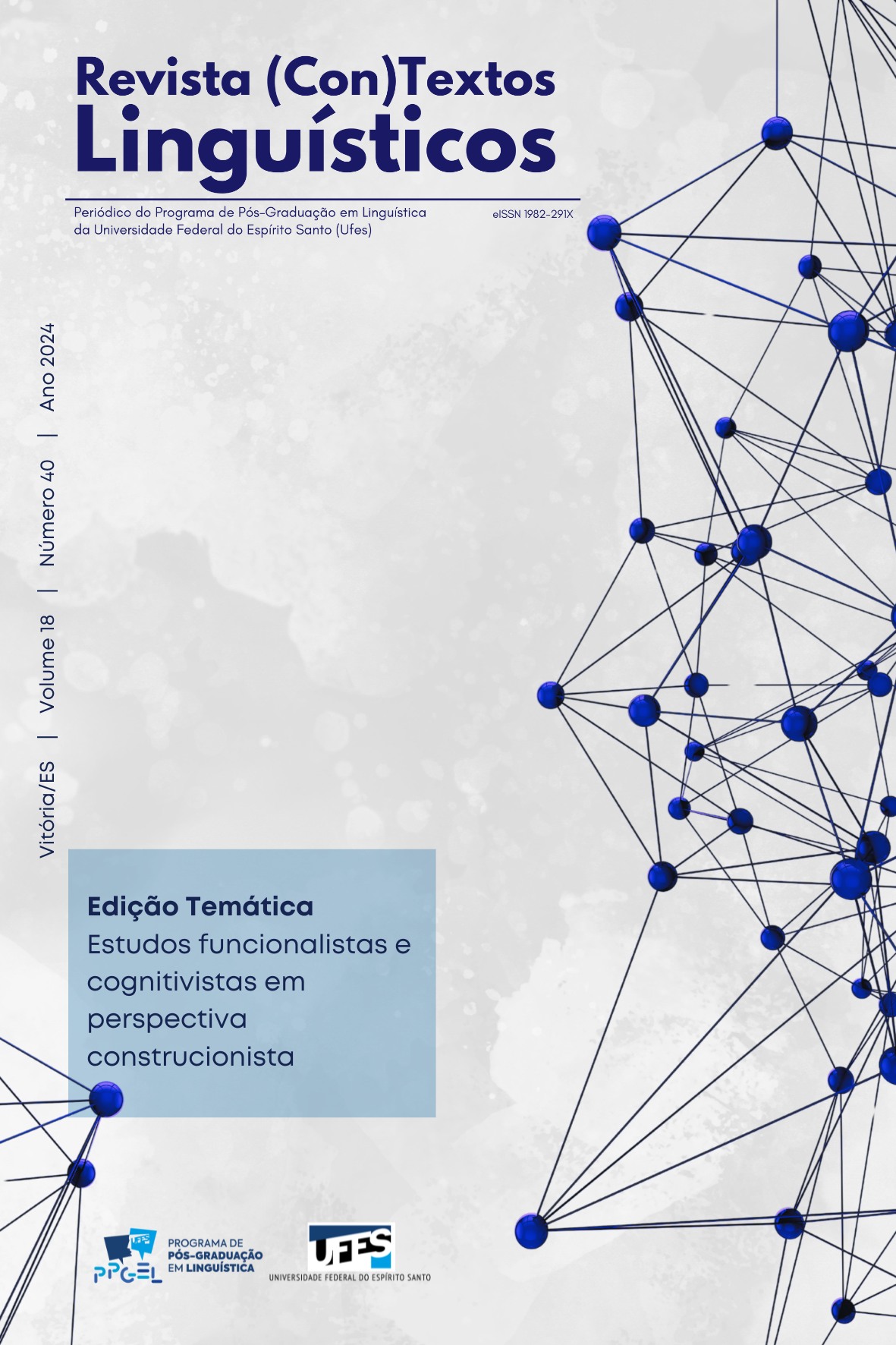"Brilhando de tão feliz"
propriedades formais e semânticas da construção graduadora de causa-efeito com intensificador
DOI:
https://doi.org/10.47456/rctl.v18i40.45110Palavras-chave:
Graducação, Intensificação, Construção, Linguística Funcional Centrada no UsoResumo
Focalizamos, neste artigo, aspectos formais e funcionais, particularmente semânticos, de uma estratégia de intensificação calcada na relação causa-efeito. Trata-se da construção graduadora de causa-efeito com intensificador (CGCEI), a qual licencia expressões como suado de tanto estudar, brilhando de tão feliz e babando de tanta fofura. Objetivamos caracterizar, em termos morfossintáticos, essa construção, considerando suas subpartes componentes, e discutir propriedades semânticas relacionadas às suas instâncias de uso. Fundamentamo-nos teoricamente na Linguística Funcional Centrada no Uso, conforme Furtado da Cunha e Bispo (2013, 2023) e Rosário e Oliveira (2016). Em termos metodológicos, desenvolvemos uma pesquisa quali-quantitativa, de viés descritivo-interpretativista. O material empírico utilizado consiste de 444 ocorrências extraídas do Corpus do Português Now (Davies, 2018). Como resultados, constatamos que a CGCEI é composta por um elemento fixo (a preposição DE) e três subpartes não especificadas (slots X, Y, Z). Para o preenchimento desses slots, são recrutadas diferentes categorias morfossintáticas: sintagmas adjetival e verbal (para X e Z), sintagma nominal (para Z), advérbio e pronome (para Y). Aferimos oito combinações distintas de preenchimento. Em termos semânticos, verificamos que são intensificados referentes abstratos, eventos e atributos/estados/características. Também verificamos a existência de continuum de transparência/opacidade e a atuação da iconicidade nos usos da CGCEI.
Downloads
Referências
ASSIS SILVA, T. C. de. Explodir de tanto ódio: análise funcional-construcionista de [XEFEITO DE YINTENSIFICADOR ZCAUSA]GRAD. Dissertação (Mestrado em Estudos da Linguagem). Centro de Ciências Humanas, Letras e Artes, Universidade Federal do Rio Grande do Norte, Natal-RN, 2024.
BISPO, E. B.; LOPES, M. G. Linguística Funcional Centrada no Uso: teoria, método e aplicação. Revista Odisseia, Natal, v. 7, n. esp., p. i-x, 2022. DOI: https://doi.org/10.21680/1983-2435.2022v7nEspecialID28489.
BYBEE, J. Language, use and cognition. Cambridge: UCP, 2010.
CROFT, W. Radical construction grammar: syntactic theory in typological perspective. Oxford: Oxford University Press, 2001.
DAVIES, M. O Corpus do Português: NOW, 2018. Disponível em: https://www.corpusdoportugues.org/now/. Acesso em: 10 jun. 2024.
FRANCHI, C. Criatividade e gramática. São Paulo: CE/SEMP, 1991.
FURTADO DA CUNHA, M. A; BISPO, E. B. Pressupostos teórico-metodológicos e categorias analíticas da linguística funcional centrada no uso. Revista do GELNE, Natal, v. 15, n. 1/2, p. 53-78, 2013.
FURTADO DA CUNHA, M. A.; BISPO, E. B. Pra quem é, bacalhau basta: da opacidade e produtividade das construções idiomáticas. Revista Soletras, São Gonçalo, v. 39, p. 103-116, 2019. DOI: https://doi.org/10.12957/soletras.2019.38075.
FURTADO DA CUNHA, M. A.; BISPO, E. B. Linguística Funcional Centrada no Uso: caracterização teórico-metodológica e aplicação prática. In: ROSÁRIO, I. da C. (org.). Metodologia da pesquisa funcionalista. Porto Velho: EDUFRO, 2023. p. 15-36.
GIVÓN, T. Syntax: a functional-typological introduction. Amsterdam: John Benjamins Publishing Company, 1984.
GIVÓN, T. Functionalism and grammar. Amsterdam/Philadelphia: John Benjamins, 1995.
GOLDBERG, A. A construction grammar approach to argument structure. Chicago: University of Chicago Press, 1995.
GOLDBERG, A. Constructions: a new theoretical approach to language. Trends in Cognitive Sciences, v. 7, n. 5, p. 219-224, 2003.
HAIMAN, J. (Ed.). Iconicity in syntax. Amsterdam: John Benjamins, 1985.
LAKOFF, G.; JOHNSON, M. Philosophy in the flash: the embodied mind and its challenge to western thought. New York: Basic Books, 1999.
MARCONI, M. de A.; LAKATOS, E. M. Metodologia do trabalho científico. 7. ed. rev. e ampl. São Paulo: Atlas, 2010.
MARTELOTTA, M. Mudança linguística: uma abordagem centrada no uso. São Paulo: Cortez, 2011.
ROSÁRIO, I. da C. do; OLIVEIRA, M. R. de. Funcionalismo e abordagem construcional da
gramática. ALFA: Revista de Linguística, São Paulo, v. 60, n. 2, 2016.
SILVA, C. R. de O. Metodologia e organização do projeto de pesquisa. Fortaleza: Centro Federal de Educação Tecnológica do Ceará, 2004.
SILVA, J. R. Motivações semântico-cognitivas e discursivo-pragmáticas nos processos de intensificação. 2008. 307 f. Tese (Doutorado em Estudos da Linguagem) – Centro de Ciências Humanas, Letras e Artes, UFRN, Natal, 2008.
SILVA, J. R. O grau em perspectiva: uma abordagem centrada no uso. São Paulo: Cortez, 2014.
SILVA, J. R.; BISPO, E. B. Morto de inveja: a construção [X de (adv) Y]INTENS. In: BISPO, E. B.; SILVA J. R.; SOUZA, M. M. (org.). Pesquisas funcionalistas: da versão clássica à perspectiva centrada no uso: uma homenagem a Maria Angélica Furtado da Cunha. Natal: EDUFRN, 2021. p. 189-234. Disponível em: https://repositorio.ufrn.br/handle/1/6222. Acesso em: 2 jun. 2024.
SWEETSER, E. E. Modality. In: SWEETSER, E. E. From etymology to pragmatics: metaphorical and cultural aspects of semantic structures. Cambridge: Cambridge University Press, 1990. p. 49-75.
TRAUGOTT, E. C.; DASHER, R. Regularity in semantic change. Cambridge: Cambridge University Press, 2002.
TRAUGOTT, E. C.; TROUSDALE, G. Constructionalization and constructional changes. Oxford: Oxford University Press, 2013.
Downloads
Publicado
Edição
Seção
Licença
Copyright (c) 2024 Revista (Con)Textos Linguísticos

Este trabalho está licenciado sob uma licença Creative Commons Attribution-NonCommercial 4.0 International License.
Autores cedem os direitos autorais do artigo à editora da Revista (Con)Textos Linguísticos (Programa de Pós-Graduação em Linguística da Ufes), caso a submissão seja aceita para publicação. A responsabilidade do conteúdo dos artigos é exclusiva de seus autores. É proibida a submissão integral ou parcial do texto já publicado na revista a qualquer outro periódico.
Esta obra está sob Creative Commons Attribution-NonCommercial 4.0 International License.



